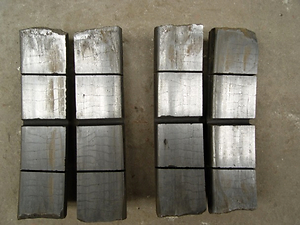New possibilities of application of composite brake
shoes fr510 type ll in freight wagons
1
SMiOC Bułhak i Cieślawski Frenoplast S.A.
Publication date: 2016-04-02
Rail Vehicles/Pojazdy Szynowe 2016,2,49-59
ABSTRACT
The article presents the possibility to apply type LL composite brake shoes, which
are not UIC-approved, in freight wagons being in service in trans-European rail
system. The publication contains an analysis of the existing European Union law
governing the interoperability of the rail system in the scope of the brake system
and shows a feasible procedure that allows cast-iron brake shoes to be replaced
with composite brake shoes in the existing rolling stock. The article presents the
results of bench and field tests of the FR510 composite brake shoe conducted in
Poland and Morocco and a comparison of the properties of this material to the
results of LL-blocks that were approved in UIC project EuropeTrain.
REFERENCES (15)
1.
DECYZJA KOMISJI 2011/229/UE z dnia 4 kwietnia 2011 r. dotycząca technicznej specyfikacji interoperacyjności odnoszącej się do podsystemu „Tabor kolejowy – hałas” transeuropejskiego systemu kolei konwencjonalnych;.
2.
Gräber J.: EuropeTrain and the Homologation of a Low Noise Brake System with LL Brake Blocks, UIC, 28t May 2013, Presentation;.
3.
UIC CODE 541-4 OR, Brakes - Brakes with composite brake blocks – General conditions for certification of composite brake blocks, 4th edition, January 2010;.
4.
DECYZJA KOMISJI 2006/861/WE z dnia 28 lipca 2006 r. dotycząca technicznej specyfikacji dla interoperacyjności odnoszącej się do podsystemu „tabor kolejowy – wagony towarowe” transeuropejskiego systemu kolei;.
5.
European Railway Agency: LIST OF FULLY UIC APPROVED COMPOSITE BRAKE BLOCKS FOR INTERNATIONAL TRANSPORT, ERA/TD/2009-02/INT, 31 May 2013;.
6.
ROZPORZĄDZENIE KOMISJI (UE) NR 321/2013 z dnia 13 marca 2013 r. dotyczące technicznej specyfikacji interoperacyjności odnoszącej się do podsystemu „Tabor – wagony towarowe” systemu kolei w Unii Europejskiej i uchylające decyzję 2006/861/WE;.
7.
Schirmer A.: Friction elements for wheel tread brakes in WAG TSI 2013 version 1.0, ERA, 7 October 2013, Presentation;.
8.
EN 14531-6:2009, Railway applications. Methods for calculation of stopping and slowing distances and immobilization braking. Step by step calculations for train sets or single vehicles;.
10.
ROZPORZĄDZENIE KOMISJI (WE) NR 352/2009 z dnia 24 kwietnia 2009 r. w sprawie przyjęcia wspólnej metody oceny bezpieczeństwa w zakresie wyceny i oceny ryzyka, o której mowa w art. 6 ust. 3 lit. a) dyrektywy 2004/49/WE Parlamentu Europejskiego i Rady;.
11.
Bułhak J., Buchalska E.: Redukcja hałasu emitowanego przez tabor towarowy poprzez zastosowanie kompozytowych wstawek hamulcowych, Technika Transportu Szynowego, 11-12/2006;.
12.
Udział PKP CARGO S.A. w projekcie UIC EuropeTrain, Gdańsk, 11 października 2011, Prezentacja;.
14.
UIC B 126/RP 43, Synthesis paper on the EuropeTrain operation with LL brake blocks - Final Report-Management Summary, February 2013, UIC Report;.
15.
Usage guidelines for composite (LL) brake blocks - Rail System Forum SET 07 – “Braking” - UIC – Question 5 – 110, 1 August 2013, 10th edition;.
CITATIONS (1):
1.
Composite brake blocks in railway freight wagons: operational problems
Patryk Nisiewicz, Wojciech Sawczuk
Rail Vehicles/Pojazdy Szynowe
Patryk Nisiewicz, Wojciech Sawczuk
Rail Vehicles/Pojazdy Szynowe
We process personal data collected when visiting the website. The function of obtaining information about users and their behavior is carried out by voluntarily entered information in forms and saving cookies in end devices. Data, including cookies, are used to provide services, improve the user experience and to analyze the traffic in accordance with the Privacy policy. Data are also collected and processed by Google Analytics tool (more).
You can change cookies settings in your browser. Restricted use of cookies in the browser configuration may affect some functionalities of the website.
You can change cookies settings in your browser. Restricted use of cookies in the browser configuration may affect some functionalities of the website.



